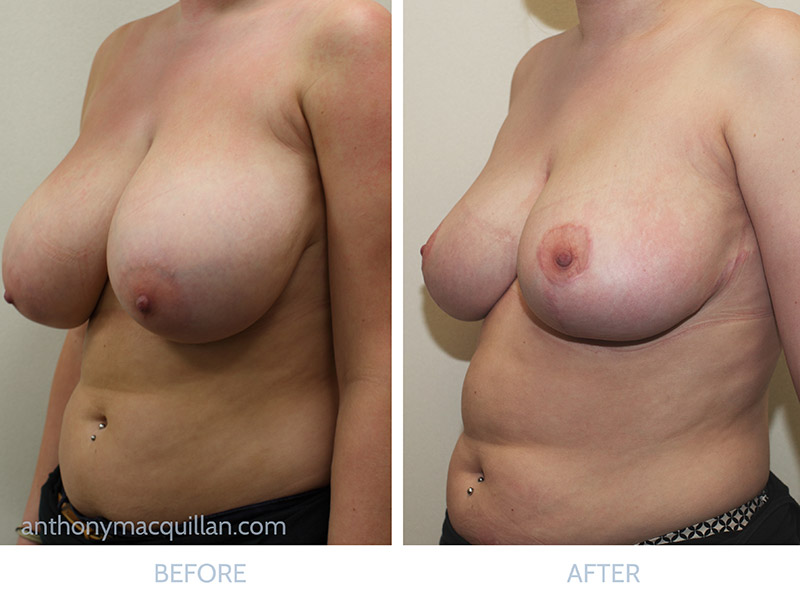Breast Reduction Surgery Can Help Alleviate Back Pain Caused by Overly Large Breasts
Back pain is a common ailment affecting a significant portion of the population at some point in their lives. While there are many causes, one less commonly acknowledged source is the size of one’s breasts. Large breasts can place additional strain on the spine and muscles of the back, leading to discomfort and pain.
This connection between breast size and back pain is not widely recognised, yet it impacts the daily lives of many individuals. The weight of excessively large breasts can alter posture, forcing the spine to curve unnaturally and muscles to work harder than usual to maintain balance. This imbalance can result in chronic back pain, affecting mobility, activity levels, and overall quality of life.
Understanding this link is the first step towards finding relief. For some, Breast Reduction surgery presents a viable solution to alleviate back pain. By reducing breast size, the strain on the back is lessened, leading to improved posture and a decrease in discomfort. This procedure, while surgical, offers a potential pathway to a more comfortable and active life.
Exploring the option of Breast Reduction surgery requires careful consideration and consultation with Consultant Plastic Surgeon Anthony MacQuillan. It’s a decision that involves weighing the potential benefits against the risks and recovery time. For those who suffer from back pain due to large breasts, understanding this surgical option can be the beginning of a journey towards a life with less pain.
Breast-Related Back Pain
The human back is a complex structure of bones, muscles, and other tissues extending from the neck to the pelvis. Large breasts can create an imbalance, demanding more from the body’s structure than it is ideally equipped to handle.
Excessively large breasts can lead to an altered centre of gravity. This shift forces the body to compensate by changing its natural posture, often resulting in a forward tilt of the neck and a curvature of the spine. Over time, these adjustments can strain muscles and ligaments, leading to persistent pain.
Moreover, the additional weight carried on the chest can compress the thoracic spine, leading to nerve compression and exacerbating pain levels. This situation is further aggravated by the constant effort to maintain an upright posture against the additional weight, causing muscle fatigue and tension in the back.
Breast-related back pain is not solely a physical issue; it affects various aspects of life, from the ability to engage in physical activities to the choice of clothing and even the type of seating that can be used comfortably. The chronic discomfort can disrupt sleep and limit participation in social and recreational activities.
Addressing this type of back pain often requires a multidisciplinary approach, including weight management, physical therapy, and, in some cases, surgery. By removing excess breast tissue, Breast Reduction surgery can significantly reduce the strain on the back, helping to restore a more natural posture and relieve pain.
Breast Reduction Surgery
Breast Reduction surgery, medically known as Reduction Mammoplasty, is a procedure designed to remove excess breast fat, glandular tissue, and skin to achieve a breast size in proportion with your body and to alleviate the discomfort associated with overly large breasts.
The procedure is not just about aesthetic enhancement; it’s a functional operation that has a profound impact on physical health. Candidates often seek relief from physical issues such as back and neck pain, skin irritation under the breast crease, and limitations in physical activity. Moreover, the surgery can lead to improved proportions, which may enhance how clothes fit and look, thereby broadening fashion choices and comfort.
The surgery itself involves several steps:
- Anaesthesia is administered for your comfort during the surgical procedures. The choices include intravenous sedation and general anaesthesia, and Anthony will recommend the best option for you.
- Incisions are made in a pattern and location determined by the breast size and shape and the extent of reduction required.
- Through these incisions, Anthony removes excess fat, glandular tissue, and skin. In some cases, Liposuction may be used to remove excess fat from the armpit area.
- The nipple, which remains tethered to its original blood and nerve supply, is then repositioned. The areola is reduced by excising skin at the perimeter, if necessary.
- The underlying breast tissue is reduced, lifted, and shaped. The incisions are then brought together to reshape the now smaller breast.
- Finally, the incisions are closed with sutures, skin adhesives, or surgical tape to close the skin.
Post-surgery, you are provided with detailed care instructions, including how to care for the surgical site, medications to apply or take orally to aid healing and reduce the risk of infection, and when to follow up with Anthony.
Recovery after Breast Reduction Surgery
The recovery period following Breast Reduction surgery is a critical component of your journey towards a life with less back pain and enhanced mobility.
Immediately following surgery, it’s common to feel tired and sore, but these symptoms should improve significantly within the first few days. You are advised to take at least a week off from work or school to focus on recovery. During this time, engaging in gentle walks around your home can aid circulation and promote healing, but strenuous activities should be avoided.
Swelling and bruising are normal and can be managed with compression garments recommended by Anthony. These garments also support the new shape of your breasts as they heal. Pain medication, if prescribed, should be taken as directed to manage discomfort.
Follow-up appointments with Anthony are crucial. These visits allow him to monitor your healing and address any concerns. It’s also a time when many patients report a noticeable reduction in back pain as the weight of their breasts decreases, leading to improvements in posture and overall comfort.
As weeks turn into months, you’ll gradually be able to resume all your usual activities, including exercise, although high-impact activities may need to be avoided for a longer period. Scars from the incisions will begin to fade but may take up to a year or more to mature fully.
Exercise and Rehabilitation Post-Surgery
In the initial weeks following surgery, your physical activity will be limited. It’s crucial to avoid any strenuous exercises that could strain your chest or disrupt the healing process. However, gentle movements, such as short walks, are encouraged to promote blood circulation and prevent blood clots.
As you progress in your recovery, Anthony or a physical therapist will introduce you to a series of exercises designed to strengthen the back, improve posture, and enhance the flexibility of the shoulder joints. These exercises are carefully selected to ensure they do not put undue pressure on the healing breast tissues.
- Arm lifts and shoulder rolls can begin a few weeks post-surgery to restore mobility and reduce stiffness in the shoulder area.
- Light stretching exercises help in regaining flexibility but should be done with caution to avoid overextension or injury.
- Strengthening exercises for the back and core will be gradually introduced to support your spine and improve posture, which is essential for long-term relief from back pain.
It’s important to closely follow the guidelines provided by your healthcare team regarding the timing and intensity of exercises. Starting too soon or engaging in vigorous activity could lead to complications or prolong the healing process. Any sign of discomfort or pain while exercising should prompt a pause and reassessment of your activity level.
Risks and Complications of Breast Reduction
Undergoing Breast Reduction surgery, like any surgical procedure, comes with its set of risks and potential complications. It’s important for individuals considering this surgery to have a clear understanding of these potential outcomes to make an informed decision:
- Infection and bleeding are risks associated with almost any surgery. While measures are taken to minimise these risks, they cannot be entirely eliminated.
- Symptoms such as excessive redness, swelling, or unusual discharge from the incision sites should be reported to your surgeon immediately.
- Scarring is inevitable with Breast Reduction surgery, though the extent and visibility of scars can vary. Anthony strives to make incisions in less noticeable areas, but the quality of scar healing also depends on individual skin types, genetics and post-operative care.
- Changes in nipple or breast sensation can occur, with some patients experiencing increased sensitivity or numbness. While these changes are often temporary, they can be permanent in some cases.
- Difficulty breastfeeding is a potential risk to consider, especially for individuals planning to have children post-surgery. Although many are still able to breastfeed, the surgery may reduce the likelihood or ability to produce a full milk supply.
- Asymmetry or dissatisfaction with the outcome is a risk, as achieving perfect symmetry or meeting all patient expectations is not always possible. Additional procedures may be required to address significant asymmetry or adjust the final breast size.
Surgery vs. Other Treatments to Alleviate Back Pain Caused by Overly Large Breasts
For individuals suffering from back pain and discomfort due to large breasts, surgery is one option among several potential treatments. Here are some other treatments that can be used to alleviate back pain:
- Physical therapy focuses on strengthening the back, improving posture, and teaching strategies to manage pain. While effective in providing relief for some, it may not address the root cause of discomfort for those with significantly large breasts.
- Pain management techniques, including medication, massage, and acupuncture, can offer temporary relief from back pain but, like physical therapy, do not address the physical burden of large breasts directly.
- Weight loss can reduce the size of the breasts somewhat if they contain a significant amount of fatty tissue. However, this approach may not be effective for everyone, as breast size is not solely determined by body weight.
- Supportive garments, such as specially designed bras, can provide better support and alleviate some discomfort. While beneficial, they often offer limited relief and do not permanently solve the issue.
When comparing these alternatives to Breast Reduction surgery, it’s essential to consider the severity of your symptoms and the impact on your quality of life. Non-surgical treatments may be suitable for those with mild to moderate discomfort or for whom surgery is not an option due to health reasons or personal preference. However, for individuals experiencing significant pain, mobility issues, or related health concerns, surgery may offer a more definitive solution.
FAQs about Reducing Back Pain with Breast Reduction Surgery
How do I know if I’m a good candidate for Breast Reduction surgery to alleviate back pain?
- You may be considered a good candidate for Breast Reduction surgery if you experience chronic back, neck, or shoulder pain attributed to the weight of your breasts. Other indicators include indentations from bra straps on your shoulders, skin irritation beneath the breast crease, and limitations in physical activity due to breast size. A consultation with Anthony, who will assess your medical history, physical symptoms, and personal goals, is the best way to determine your suitability for the procedure.
What can I expect in terms of pain relief and physical activity post-surgery?
- Many patients report significant relief from back, neck, and shoulder pain following Breast Reduction surgery. This relief can improve posture, enhance mobility, and allow for a more active lifestyle that may have been previously hindered by large breasts. While individual experiences vary, the majority of patients find they can engage in physical activities with greater comfort and less limitation after recovery.
How long is the recovery period, and what restrictions will I have?
- The recovery period can vary, but most patients can return to work and everyday activities within 2 to 3 weeks, with a full return to physical exercise within 6 to 8 weeks post-surgery. It’s essential to avoid heavy lifting and strenuous activity during the initial recovery phase to allow proper healing. Anthony will provide specific guidelines based on your surgery and overall health.
Will my ability to breastfeed be affected by Breast Reduction surgery?
- Breast Reduction surgery can potentially impact your ability to breastfeed, depending on the technique used and the extent of tissue removal. While many women are still able to breastfeed after surgery, discussing your plans for future breastfeeding with Anthony before the procedure is important. He can tailor the surgical technique to preserve as much lactational ability as possible.
What are the chances of my breasts growing back after Breast Reduction surgery?
- Breast regrowth after Reduction surgery is uncommon but can occur with significant weight gain, hormonal changes, or pregnancy. Maintaining a stable weight and a healthy lifestyle can help preserve your surgical results.
Further Reading about Breast Reduction Surgery
- Visible Effects of Ageing That Can Be Improved with a Facelift
- Top Tips to Sleep Better After Facelift Surgery
- Stitches after Blepharoplasty
- How to Reduce Bruising and Swelling after Facelift
- Recovery after Neck Lift Surgery
Medical References about Breast Reduction Surgery
- Does Breast Reduction surgery improve health-related quality of life? A prospective cohort study in Australian women – NCBI
- Long-term outcomes of Breast Reduction surgery – Science Direct
- Breast Reduction Surgery: An Overview – WebMD
- Breast Reduction Surgery: What Every Woman Needs to Know – Science Direct
- Breast Reduction – Cleveland Clinic



